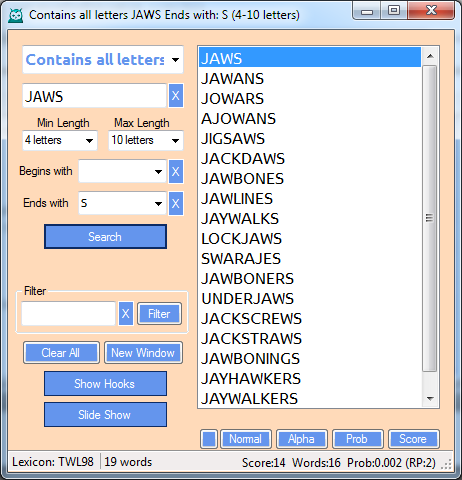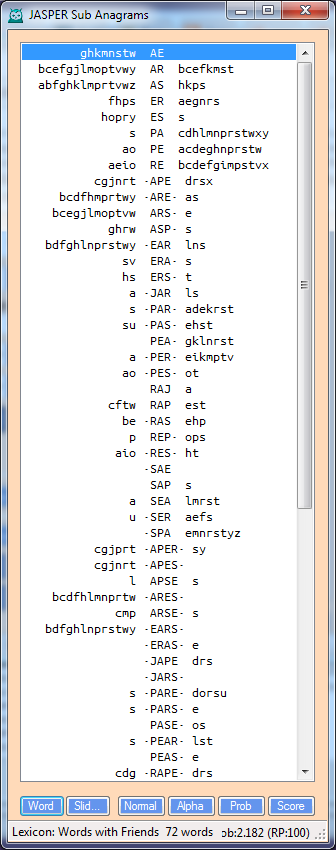Searching with Hoot
There are many types of searches you can do in Hoot. Many of them are accessible from either the Predefined Lists or the Combination Search. See the complete list of searches available in Hoot.
The Search Screen
Most search screens look the same, with an entry box, a search button(s), and an assortment of options. After searching for a set of words you can also reformat the display, sort, or choose to view a slide show. You can even do a popup search of one of the words in the list.
Show Hooks
Most windows also have a Show hooks option that will display the letters that can be added in front or behind the word to form another word. The display shows what letter can be added to the front or back of the word to form another word. There is also a bullet in front or back of the word if the letter can be subtracted from the word to form another word.
Filter
In some search screens you can include filters as a part of the search. For example, you can limit the results by prefix, suffix, minimum and maximum number of letters, and enter a set of letters and continually filter the list by what is in that filter.
Slide Shows
Most searches have a slide show button that will display the words individually in a separate window, and allow showing other searches of selected words. One of the best study techniques available in Hoot involves using the Slide Show and the subsearches there. For example, you can start with all of the four letter words containing a J. In the Slide show you can then view the anagrams, hooks, or extensions, etc for each of those words.
The Stems screen has a special search that shows the stem list with blank anagrams for each stem. Read more about this in Slide Shows.
Sorting
The lists are generally displayed first by length and then alphabetically. That is what I consider to be a normal sort. Three other sort options are also available. You can sort straight alphabetical, by probability, and by score. When a sort option is selected, the button colors are reversed. Pressing the same button again will reverse that sort. You can also press the arrow to reverse the sort.
Context Menu
A context menu is available from most screens, including itself. With it you can generate results based on the selected word which will be shown in a separate popup window, or simply open the results in a separate popup window while you continue to execute other searches. You can also do things with the complete list like copy or save. The Combination window will even let you save or load searche parameters. Read more about context menus in Context Menus.
Resizing
As you use Hoot you may also discover another feature. As the search screen windows are resized, the list and controls respond to the size, so you could make the list a long skinny one to see more words at once, or a shorter one to save screen space. There are some limits, but in fact, you could resize a search screen so that the sort options are not visible and not accessible. In addition to resizing the search window the popup windows can also be resized.
Status Bar
The status bar at the bottom of each search screen shows the status of operations as well as characteristics of the selected word or list. If a word is selected in the list, the status bar will show the current lexicon, the word index, or the word number and the total number of words, on the left. On the right are shown statistics for the word. Currently, it shows the raw score for the word, the score in a WWF game, the probability, and the relative probability. The probability is the combinational probability, while the relative probability is the probability in relation to other words of the same length. The RP normally ranges from 1 to 100.
Note that the probabilities are based on drawing from a full bag of tiles. The only time that really happens is when the first player draws his 7 tiles. After that, probabilities will vary depending on the tiles actually left in the bag.


